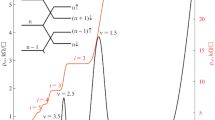Conclusions
The two-band model described here, based on the parabolic dispersion law and elastic scattering approximation is capable to explain many aspects of the Shubnikovde Haas effect, although the elastic scattering approximation is not suitable for ail experiments mentioned.
We have satisfactorily explained the phase shift between oscillations of different components of the resistivity tensor. The oscillation amplitude of the longitudinal magnetoresistance Bi can also be well fitted. These effects have been interpreted by authors of the experiments [2, 3] in another way, based on the assumption of dominant contribution of inter-level scattering. They obtain a worse fit and also their Dingle temperatureT D=15 K is less realistic thanT D=3 K suitable for the fitting presented in section 5b of this paper.
It has also been shown that the oscillation amplitude of the transverse and nondiagonal (Hall) components of the resistivity is strongly affected by the difference between the numbers of electrons and holes. This effect might also be responsible for the large enhancement of the oscillation amplitude due to alloying in Bi, doped with Sb [1], as in available samples the precise compensation is usually not achieved.
Similar content being viewed by others
References
Hiruma K., Kido G., Kawauchi K., Miura N.: Solid State Commun.33 (1980) 257.
Tanuma S., Inada R.: Prog. Theor. Phys. Suppl. (Japan)57 (1975) 231.
Tanuma S., Inada R.: Phys. Condensed Matter19 (1975) 95.
Bogod Yu. A., Krasovitsky V. B.: Solid State Commun.28 (1978) 659.
Toyoda K.: J. Phys. Soc. Japan38 (1975) 1543.
Sondheimer E. H.: Proc. Phys. Soc. London A65 (1952) 561.
Středa P., Smrčka L.: Czech. J. Phys. B31 (1981) 1114.
Chen A., Weisz G., Sher A.: Phys. Rev. B5 (1972) 2897.
Harrison W. A.: Teoriya tverdovo tela, Mir, Moskva, 1972, p. 436.
Sham L. J., Ziman J. M.: Solid State Phys.15, (1963) 221.
Tanaka S., Morita T.: Prog. Theor. Phys.47 (1972) 378.
Smrčka L., Středa P.: J. Phys. C: Solid State Phys.10 (1977) 2153.
Roth L. M., Argyres P. N.: Semiconductors and Semimetals 1 (ed. R. K. Willardson and A. C. Beer), Academic Press, New York, 1966, p. 159.
Olsen J. L.: Electron Transport in Metals, Wiley & Sons, New York, 1962, p. 61.
Giriat W.: Phys. Lett.24A (1967) 515.
Hartman R.: Phys. Rev.181 (1969) 1070.
Author information
Authors and Affiliations
Rights and permissions
About this article
Cite this article
Středa, P. Oscillation amplitudes of the Shubnikov-dehaas effect. Czech J Phys 33, 49–64 (1983). https://doi.org/10.1007/BF01597337
Received:
Issue Date:
DOI: https://doi.org/10.1007/BF01597337




